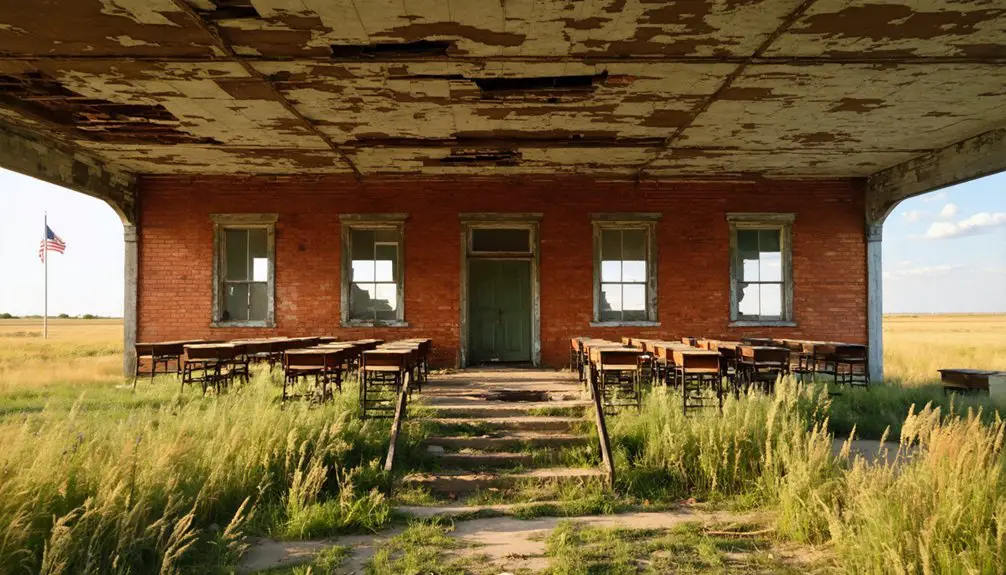Trousdale, Oklahoma, emerged in 1904 following the Santa Fe Railroad’s arrival, named after Sheriff Billy Trousdale of Pottawatomie County. You’ll find this ghost town 6 miles south of Tribbey, where it once flourished with three daily trains and prosperous oil operations. The community thrived until mid-20th century, when declining oil production and school consolidation led to its abandonment. While most structures have decayed, Trousdale’s rich history of boom-and-bust frontier life holds countless untold stories.
Key Takeaways
- Founded in 1904 near the Santa Fe Railroad, Trousdale thrived as a transport hub before declining and becoming an official ghost town.
- Located 6 miles south of Tribbey at 960 feet elevation, the town is accessible via Oklahoma State Highway 102.
- The town’s decline followed the end of the oil boom, with its economy shifting from oil production to agriculture.
- Historic structures including a community building and former railroad depot remain in various states of decay.
- The town merged its school district with Tribbey in 1957, marking a significant turning point in community decline.
The Birth of a Railroad Town
As the Santa Fe Railroad extended its tracks through Pottawatomie County in 1903, the settlement of Trousdale emerged on March 7, 1904, marking the birth of another Oklahoma railroad town.
You’ll find its origins deeply rooted in the railroad’s significance, as the town was strategically positioned to serve as an essential transportation hub for the region’s smaller communities. Similar to other communities during this era, the town’s location and development were shaped by railways that determined valuable settlement areas.
Named after William F.A. “Billy” Trousdale, the former sheriff of Pottawatomie County, the town quickly attracted merchant migration from nearby Moral.
The legacy of Sheriff Billy Trousdale lives on in this small railroad town, where merchants found new opportunities and prosperity.
A.N. Trousdale, a local merchant, served as the Santa Fe Railroad depot agent, symbolizing the close relationship between commerce and rail service. The town flourished with three daily trains connecting residents to surrounding communities.
The railroad’s presence established Trousdale as a key link in connecting rural communities like Henderson, Heshel Box, and Centerpoint, while facilitating the transport of goods and mail throughout the county.
Legacy of Sheriff Billy Trousdale
The enduring legacy of William F.A. “Billy” Trousdale extends far beyond his role as Pottawatomie County’s first elected sheriff in 1895. You’ll find his influence woven into the very fabric of early Oklahoma governance, where he represented stability during the county’s formative years.
Trousdale’s influence manifested most visibly in the town that bore his name, established in 1904 following the railroad’s arrival. The town’s name required clear disambiguation pages to distinguish it from other Trousdale locations. Unlike modern sheriffs who often face allegations of unchecked power, Trousdale maintained strict accountability standards.
While the physical town of Trousdale may have faded into ghost town status, Sheriff Trousdale’s legacy lives on through his family’s continued service to the community. His relatives, particularly A.N. Trousdale, carried forward this tradition of public service through merchant activities, railway operations, and civic leadership.
Today, you can trace the Sheriff’s legacy through historical records, his Tecumseh gravesite, and the indelible mark he left on Pottawatomie County’s development.
Early Settlement and Development
Founded on March 7, 1904, Trousdale emerged following the railroad’s arrival in 1903, establishing itself 6 miles south of Tribbey at an elevation of 960 feet near present-day Oklahoma State Highway 102.
As neighboring Moral declined, merchants relocated their businesses to this promising new settlement, laying the foundation for a thriving agricultural community. Like in Sumner’s early development, about half of the initial settlers departed shortly after arrival.
- Early settlers capitalized on the railroad’s presence, establishing three daily train stops to serve Henderson and Avoca.
- Agricultural practices formed the economic backbone, supported by an active 4H club promoting farm education.
- The community’s growth centered around the railroad depot, managed by the influential Trousdale family.
- Three rural mail routes connected the scattered farmsteads, maintaining essential communication links across the territory.
The settlement’s strategic location and transportation infrastructure attracted rural residents, fostering a self-sufficient community focused on agriculture and commerce.
Railroad’s Influence on Growth
The arrival of the Santa Fe Railroad in 1903 transformed Trousdale into a crucial transport hub, prompting merchants to relocate from nearby Moral and establishing new commercial networks throughout the region.
You’ll find that the railroad’s presence attracted three daily trains serving passengers and freight, while also supporting three rural mail routes that connected Trousdale to communities like Henderson, Heshel Box, and Centerpoint.
The rail line’s construction reshaped local trade patterns, as Trousdale became integrated into Oklahoma Territory’s broader railroad expansion of 1897-1907, which linked agricultural areas and fostered rapid development across the region. This development mirrored the rapid growth seen across Indian Territory, where six thousand miles of track were laid by 1910. Like many early rail projects, the development faced potential setbacks but avoided the financial troubles that led other railways into receivership during this era.
Rail Line Construction Impact
Following the arrival of railroad service in 1903, Trousdale emerged as a vibrant commercial hub along the Santa Fe line, drawing merchants and residents from nearby settlements like Moral.
The railroad expansion catalyzed an economic transformation that positioned Trousdale as a strategic node within Oklahoma’s evolving transportation network. The post-Civil War treaties had paved the way for railroad development through Indian Territory, enabling towns like Trousdale to flourish.
- Three daily trains and multiple rural mail routes connected you to regional commerce and communication
- Foreign investment in rail infrastructure highlighted Trousdale’s role in larger trade corridors
- The Santa Fe depot, managed by A.N. Trousdale, served as a crucial business and civic center
- Strategic rail line placement along established trade routes strengthened Trousdale’s commercial significance
The competitive race to construct rail lines through Indian Territory placed Trousdale at the intersection of north-south and east-west corridors, cementing its importance in regional development.
Early Transport Hub Development
Spurred by the railroad’s arrival in 1903, Trousdale rapidly evolved into an essential transportation nexus where commerce and communication converged. The town’s transportation evolution manifested through multiple daily trains, an active depot, and three rural mail routes that connected surrounding communities like Henderson, Heshel Box, and Centerpoint.
You’ll find evidence of significant economic changes as merchants relocated from nearby Moral to capitalize on Trousdale’s rail advantages. The depot agent became a pivotal figure, orchestrating the flow of freight, passengers, and crucial communication services through telegraphy.
The railroad’s influence extended beyond commerce, helping consolidate rural schools and establish more centralized civic institutions. This transportation hub would sustain local businesses for decades, with some merchants maintaining operations for over 40 years.
Regional Trade Route Shifts
As railroad companies rapidly expanded across Indian Territory between 1897 and 1907, traditional trade routes underwent dramatic transformation.
You’ll find this trade route evolution particularly evident in how rail lines systematically replaced established paths like the Chisholm Trail, reshaping the region’s economic landscape. Railroad development created new transportation corridors that revolutionized commerce and connectivity.
- Rail companies strategically built lines that intersected at key points, establishing crucial trade hubs like Trousdale.
- Your community’s survival depended on securing railroad access, as towns bypassed by rail lines often faced economic collapse.
- Foreign investment from European sources fueled aggressive railroad expansion, intensifying regional development.
- You’d see dramatic shifts in trade patterns as rail connections linked Oklahoma’s resources to distant markets.
Community Life and Infrastructure
While Trousdale never developed extensive municipal infrastructure, the town maintained a vibrant community life centered around its railroad depot, post office, and community building.
You’d find the heart of community gatherings in the multipurpose community building, where Methodist meetings took place without a formal church structure.
The town’s rural connections were strengthened through three daily train services and a network of rural mail routes serving Henderson, Heshel Box, Centerpoint, Pearson, and Avoca.
Regular train service and extensive mail routes wove Trousdale into the fabric of nearby rural communities like Henderson and Pearson.
Like many Oklahoma communities facing economic changes, Trousdale experienced a gradual decline similar to Acme’s cement operations that sustained hundreds of workers in their peak years.
The 4H Club, led by Mary Robinson, provided youth engagement opportunities, while dedicated mail carriers like R.M. Herd, W.E. Childs, and Ollie Morphew maintained essential communication links.
Until its closure in 1967, the post office served as a significant hub for both social and economic activity, binding together this independent rural community.
Educational Changes and Integration

As Trousdale’s student population shifted during Oklahoma’s integration period, you’ll find that the school district faced significant changes through consolidation with neighboring Tribbey in 1957.
You can trace the district’s evolution within the broader context of statewide rural school mergers, which aligned with Governor Raymond Gary’s 1955 education funding reforms aimed at encouraging desegregation.
Your examination of Trousdale’s educational transformation reveals how rural communities adapted to both demographic changes and integration mandates through strategic district reorganization. Like many districts across the state, Trousdale’s schools operated under the separate but equal doctrine until reforms were enacted.
School District Consolidation History
During the early twentieth century, Trousdale’s educational landscape underwent significant evolution through a series of strategic consolidations.
You’ll find that four rural schools – Pioneer near Moral, Griffin, Greenleaf, and Pitman – merged to form the Trousdale school district, marking a vital shift in local educational changes. These consolidation challenges culminated in 1957 when the community voted to annex their district to Tribbey.
- The district maintained strong community ties through 4H programs despite having no churches
- Local leadership played an essential role in managing educational changes
- The 1967 post office closure paralleled the district’s declining centralization
- Oil discovery in 1950 had minimal impact on the district’s consolidation patterns
Population Impact On Education
The steady decline of Trousdale’s population after the mid-20th century directly shaped its educational landscape. As student numbers dwindled, educational sustainability became increasingly challenging, ultimately leading to the 1957 decision to annex Trousdale’s school district into nearby Tribbey’s system.
This consolidation marked a significant shift in community identity, as Trousdale lost independent control over its educational institutions. While the merger provided access to broader resources and potentially enhanced curriculum offerings, you’ll find it also required substantial social adjustments for local families.
Students faced longer commutes and integration into a more diverse school population. The experience reflects a broader pattern you can observe across Oklahoma’s rural communities, where population losses have consistently driven educational restructuring and the centralization of school districts.
The Gradual Decline
While Trousdale initially flourished after the Santa Fe Railroad’s arrival in 1903, its gradual descent into ghost town status stemmed from a complex interplay of economic and social factors.
You’ll find that the town’s economic shifts began when the railroad’s influence waned, and despite the community’s resilience, several critical developments hastened its decline:
- The 1957 annexation of Trousdale’s school district to Tribbey marked a pivotal loss of educational independence.
- The 1950 oil discovery near town failed to generate sufficient economic momentum for revitalization.
- The absence of church buildings and limited institutional infrastructure weakened community cohesion.
- The 1967 post office closure effectively ended Trousdale’s status as an official community.
These changes, combined with the growing pull of larger towns like Shawnee, transformed Trousdale from a bustling railroad town into a quiet remnant of Oklahoma’s past.
Lost to Time: Ghost Town Status

As railroad activity diminished and local services consolidated elsewhere, Trousdale’s transformation into a ghost town became complete by the late 1960s.
You’ll find the final chapter of this once-vibrant community marked by the closure of its post office in 1967, following the earlier loss of its school district to Tribbey in 1957.
While community nostalgia lingered through social gatherings and 4H club meetings, the town’s physical presence gradually faded into Oklahoma’s landscape.
Today, at 960 feet elevation and six miles south of Tribbey, Trousdale stands as a reminder of the shifting fortunes of rural America.
Where three daily trains once brought life and commerce, only ghost stories and memories remain, punctuated by the symbolic destruction of its mail cancellation markers – the final erasure of its official identity.
Historical Impact on Pottawatomie County
From its establishment in 1903, Trousdale emerged as a significant force in shaping Pottawatomie County’s early development through its prominent civic leadership and economic contributions.
The town’s civic engagement was exemplified by the Trousdale family, who produced the county’s first elected sheriff and maintained leadership roles in local governance.
- W.B. Trousdale’s appointment as the first county sheriff in 1895 established a legacy of law enforcement leadership.
- A.N. Trousdale’s 43-year merchant career and role as Santa Fe Railroad depot agent demonstrated economic resilience.
- The consolidation of four rural schools showcased the town’s commitment to educational advancement.
- Three daily trains and rural mail routes positioned Trousdale as a crucial transportation hub.
You’ll find Trousdale’s influence extended beyond its borders, fostering regional connectivity and shaping the county’s early institutional framework.
Frequently Asked Questions
Are There Any Remaining Structures or Ruins Visible in Trousdale Today?
Ever wonder what time leaves behind? You’ll find it’s uncertain whether any remaining structures or visible ruins exist in today’s landscape, as no documented evidence confirms standing buildings or foundations.
What Natural Disasters or Events Contributed to Trousdale’s Population Decline?
You won’t find evidence of tornado impacts or drought effects driving Trousdale’s decline. Instead, economic shifts and transportation changes, particularly declining railroad significance, caused the population to dwindle over time.
Where Did Most Trousdale Residents Relocate After Leaving the Town?
You’d be shocked to discover that relocation patterns and resident testimonies suggest most folks made the logical 6-mile trek north to Tribbey, following their school district’s annexation and seeking essential services.
What Crops or Agricultural Products Were Primarily Grown Around Trousdale?
You’ll find that cotton farming dominated Trousdale’s agricultural landscape, with significant corn production serving both as a cash crop and sustenance. Local farmers also grew soybeans, peanuts, and alfalfa for diversification.
Did Any Famous Outlaws or Historical Events Occur in Trousdale?
Despite having three daily trains in 1904, you won’t find major outlaw legends here. The town’s historical significance centered on the Trousdale family’s lawmen, particularly Sheriff W.B. Trousdale, elected in 1895.
References
- https://en.wikipedia.org/wiki/Trousdale
- https://sites.rootsweb.com/~okpcgc/towns/moral.html
- https://www.potawatomi.org/blog/2021/04/09/remembering-potawatomi-ghost-towns/
- https://www.okhistory.org/publications/enc/entry?entry=GH002
- https://pastmaps.com/explore/us/oklahoma/pottawatomie-county/trousdale/metal-detecting
- https://sites.rootsweb.com/~okpcgc/towns/trousdale.html
- https://npshistory.com/newsletters/crm/crm-v22n10.pdf
- https://www.wikiwand.com/en/articles/Trousdale
- https://www.youtube.com/watch?v=ZECIA5sF164
- https://fr-ca.findagrave.com/memorial/12125423/william-bell-trousdale



